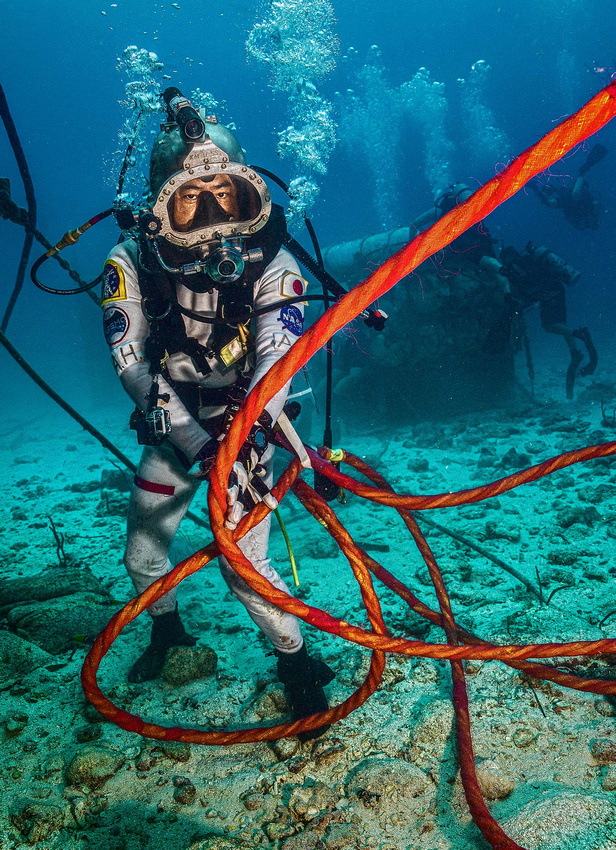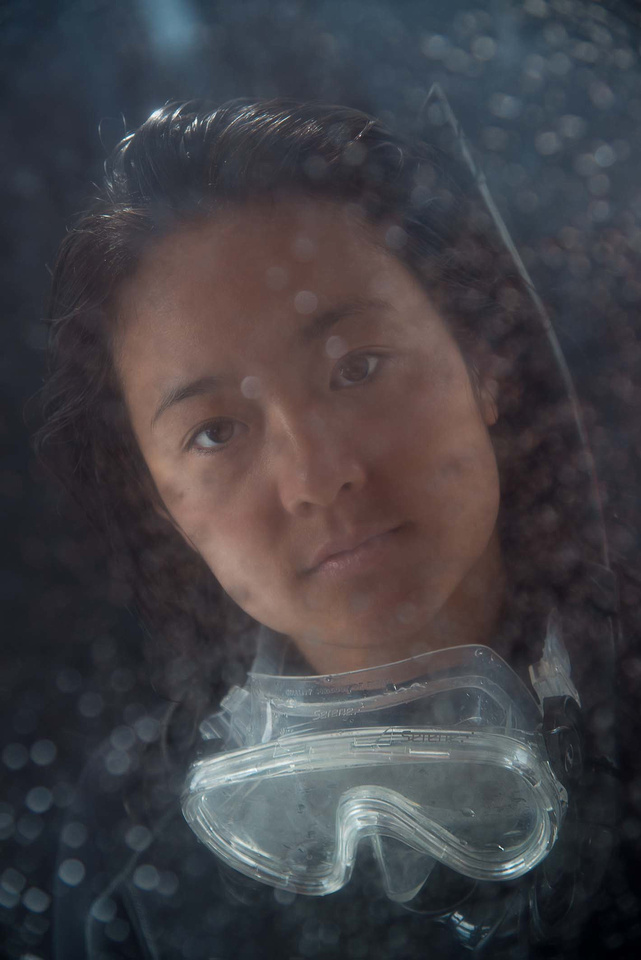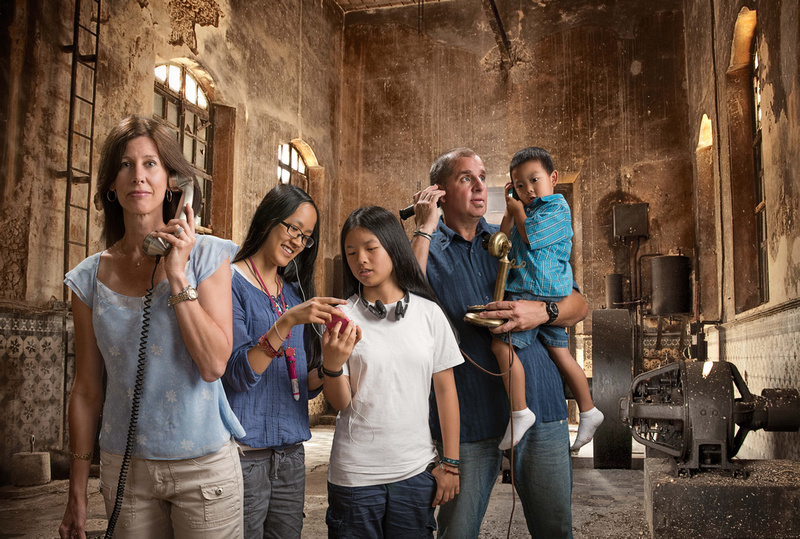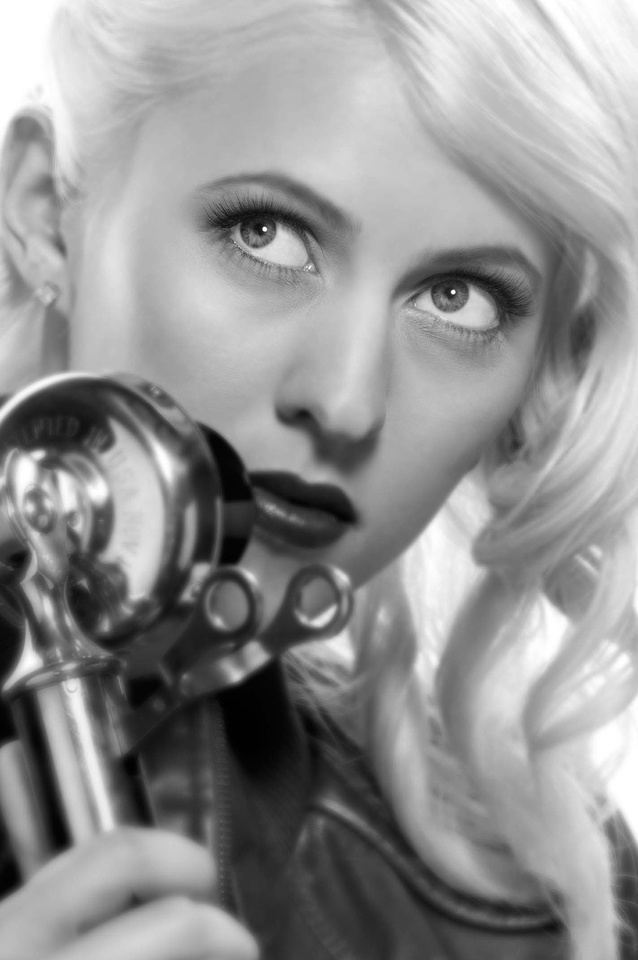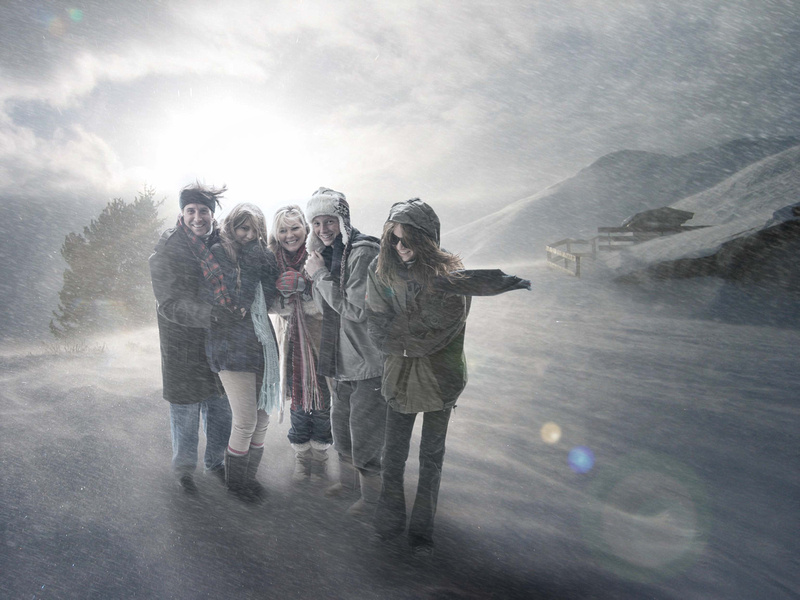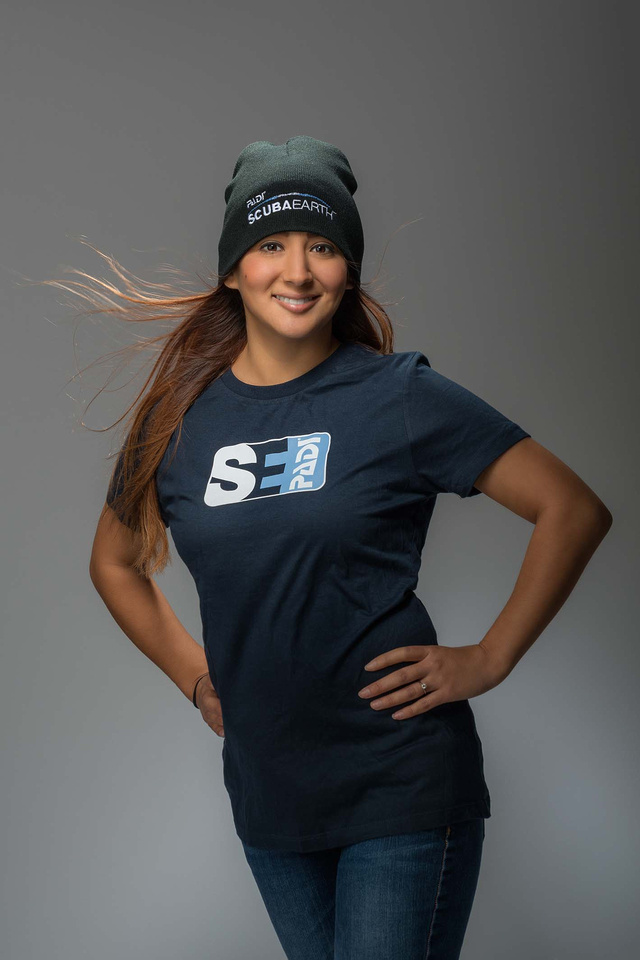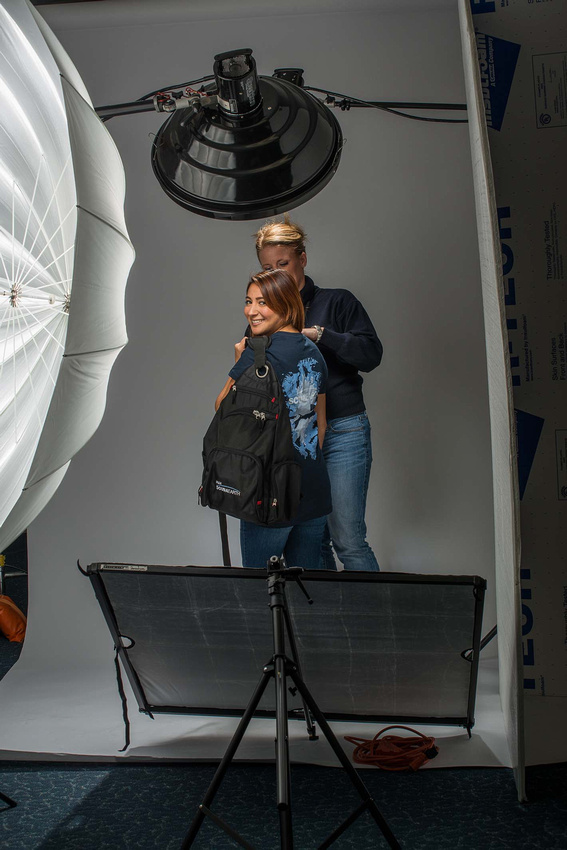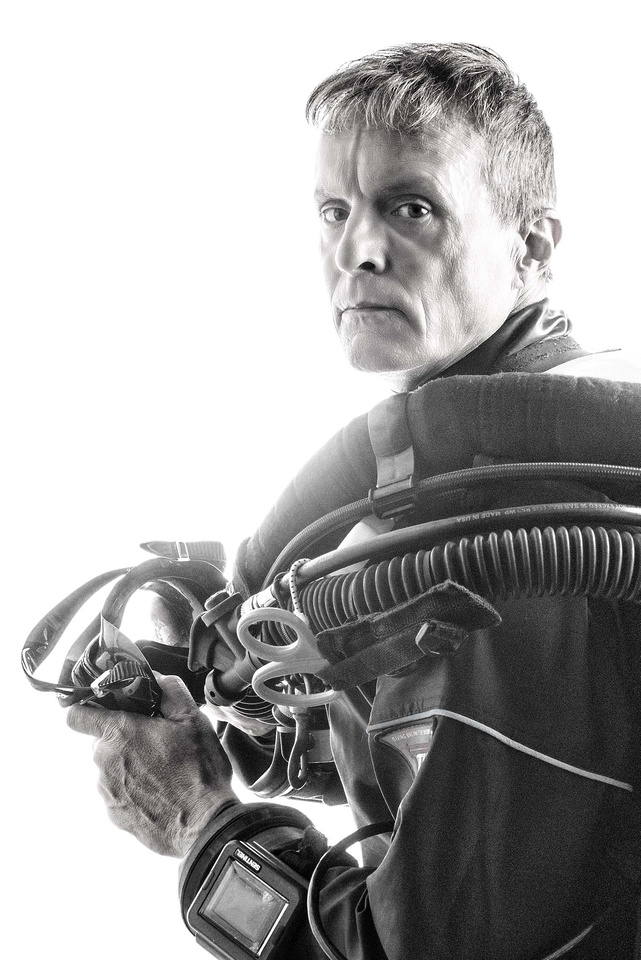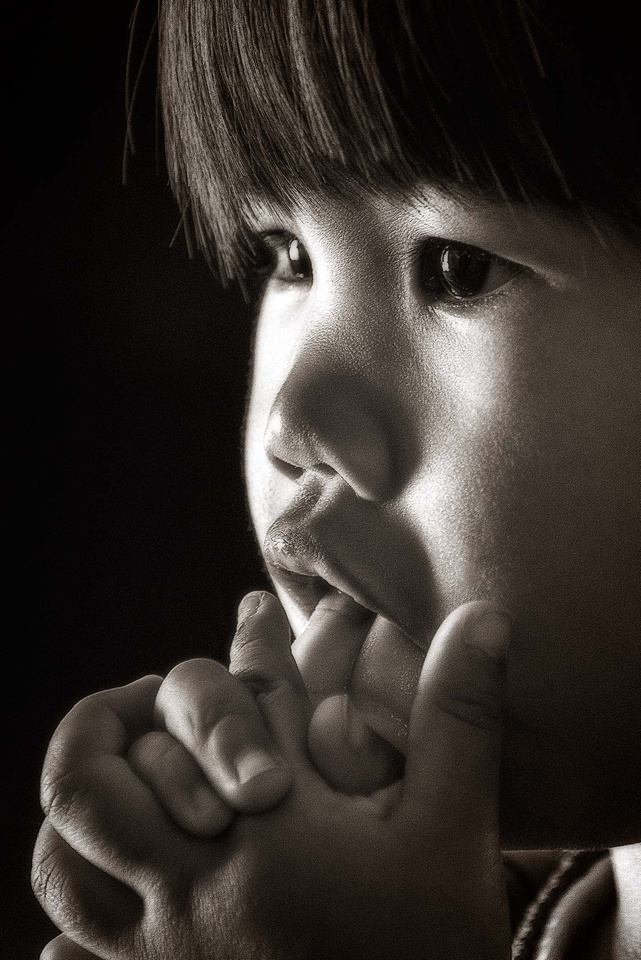|
Welcome to my online column. It's a few notes on what happens on different photo shoots and thoughts about shooting and image processing that may be useful to you if you're looking for my services as a photographic artist, or if you're a fellow shooter/image maker who works in the same areas in which I do. What Really Matters
This shot of my daughter's worth a million to me, but not because it's a nice photo. Certainly people relate to it, and they've given me kind words about her gleeful expression, or how it takes them back to when Daddy pushing you on a swing was one of life's greatest joys. Her delight's genuine, and you can see it. But, while it's great to create a good image, there are many things that are more important.
What makes this image special is that in it, we see changed lives – my daughter's, my wife's and mine. Since there are other pictures of her and of me on this site, you may realize that we adopted her. I can't imagine what it's like for anyone to grow up without loving parents, but it makes me wonder whether she would have had moments like these. On the other hand, I now know what my wife and I would have missed; thinking what might not have been makes me weep.
Too many children grow up without families; there are about 153 million orphans in the world who have lost one or both parents (and one is too many). But, considering there are about 1.4 billion families (households) if only about 1 in 9 adopted one child, we could close every orphanage. Not every household can do so, but others would (and do) adopt two or more. And, of the 153 million, many still have a parent and a viable family. My point is that this should be a solvable problem.
To be direct, what about you? If you're thinking about enlarging your family, give it some serious thought. For those who may feel the same way, I wasn't sure I wanted to adopt. If I'm honest, I was basically dragged into it. But my fears, concerns, worries and hesitation vanished the instant I held my little girl for the first time, and now I thank God that He didn't let me off the hook on this one. When you become an adoptive parent, you give a lot, but you get a lot more than you give. For every smile we've put on our little girl's face, she's put a hundred on ours. I think it's one of God's ways of teaching us what's really important.
Twenty Thousand Dollars Under the Sea
Background: In my November 2012 blog post, I wrote that the Aquarius undersea habitat -- the ocean equivalent of the International Space Station -- was about to close due to lack of funding. With it, the NASA Extreme Environments Mission Operations (NEEMO) programs were in peril, potentially ending more than a decade of researching human spaceflight under the sea. Fortunately, as shown in an update, at the last minute Florida International University took up the reins of funding and managing this imporant national resource.
After nearly coming to an end in 2012, two years later the NEEMO project has come back strong, with two missions, NEEMOs 18 and 19, in 2014. At this writing, NEEMO 18 just concluded (very successfully), with NEEMO 19 about three weeks away. Having been a contractor with the NEEMO project since its inception in 2001, over the years I've "worn many hats," including, at times, photographer. On NEEMO 18 shooting wasn't my primary role (I was primarily a support diver); that duty fell to accomplished imager Mark Widick (check out his amazing space shuttle launch shots!), who was sporting a Hasselblad H3D in an underwater housing.
If you're not a photographer, you may not know that Hasselblad is considered the highest quality professional camera available. Hasselblad makes each with a unique combination of mass production and hand crafting, with a large sensor and the world's finest lenses. Its current top end model (the H5D-60) is a 60 megapixel camera (about twice the resolution of the current highest DSLR sensor at 36 megapixels), which continues a 50+ year trend. During that span, Hasselblad has been the tool of choice in the fashion industry and other high-end imaging, including being the camera that went to the moon. No one argues that Hasselblad is the best of the best for high end, commercial imaging.
But, it's a high-ticket item -- an order of magnitude more costly than the finest Nikon and Canon DSLRs (you want the best, you have to invest), so while I shot Hasselblad a lot during the film era, until NEEMO 18 I'd never had a chance to shoot the new digitals. They were out of reach for me financially. Mark could see the longing (i.e., envy, lust, jealousy) on my face and, being a kind and merciful person, graciously handed his Hassy to me during two dives in which I was, at least officially, just his dive buddy. While I can hardly say I shot it enough to get to know it well, I immediately fell in love -- you have to shoot to understand it, but just feels right. With it, I captured several images I like, including this one of NEEMO 18 mission commander astronaut Akihiko Hoshide of the Japan Aerospace Exploration Agency. For this shot, I was under the Aquarius habitat (it's on a frame about 20 feet off the bottom) at the end of a simulated EVA (Extra Vehicular Activity, a.k.a. "space walk") as he was securing his life support umbilical. He turned from his task for just a beat and looked my way, giving a shot that connects you with him.
After one of our many dives during the mission, someone helped Mark by taking his camera system from him as he came out of the water. "Careful with that," I cautioned, "That's $20,000 under the sea." I wish I created this little play on words, but actually pioneer underwater photographer Jerry Greenberg did. He published an image with that title in the early 1960s, showing all the equipment he used as an early pro underwater photographer -- multiple underwater camera systems, scuba gear, several scuba cylinders -- even a boat -- all of which the caption said came to a bit more than $20K.
That says something about inflation over the last 60+ years, to be sure, but even so, I don't think he had a Hassy. He'd have loved it if he did.
Finding Your Muse
Every artist needs inspiration. What we create comes from a vision within us (albeit, often augmented and improved by the team who we work with as it comes forth), but something needs to inspire that vision. It may another artist's work, a phrase, a random thought, a dream -- but it has to be something. Or, someone, a muse –- an inspiring model, actor or collaborator or who pulls new, fresh creative visions out of us. It's magical and wonderful when you find yourself in a muse-artist relationship.
The muse-artist relationship is not monogamous, and it can be momentary or enduring. Fashion/portrait photographer Richard Avedon was a muse-magnet extraordinaire and illustrates this. Some of his most famous images feature Brook Shields, Judy Garland, Marilyn Monroe, Dovima, Stephanie Seymour, Brigitte Bardot, and Audrey Hepburn, to name only a few. Avedon photographed most of these a few times at most, yet his work exhibits the inspiration he drew from them. Hepburn, however, modeled for him many times over both their careers; together they created many of the images we think of when we think of Audrey Hepburn. The Avedon-Hepburn tie has become almost the stereotype for muse-artist relationships.
You can't decide to be someone's muse, and you can't decide someone will be your's. It's also not romantic. While it can be, that's not it. In my experience, there's a sense akin to falling in love, but it's at most an illusory crush that fades when we stop shooting. Then we're back to being friends/acquaintances. I can't explain what makes someone your muse, but you know it when it happens.
During a shoot last week, I found a muse, actor Charlie Seibold, and this is one shot that, at least in my eyes, shows it. We were shooting on a dive boat, and this shot through a splashed window was a magic setup in which everything came together way easier than it should. She gave me several looks that work, but I love her expression in this frame. It says she's strong, confident and at peace (which is probably why she's also a skilled free diver).
Will she be a my muse again? It doesn't always work that way. But, sometimes it does. We'll see.
A Voice for the Masses
Whether you're a photographer, photographic artist or just have some photos that fit into a story you want to share, Adobe has a new free app to check out: Adobe Voice. It's an app that lets you easily create a short video about a problem, principle, proposition or just a story. It uses your photos as well as free logos and photos within the Adobe Creative Cloud, and walks you through the process, all within your iPad. It is easy, and effective -- just don't get long winded. It's for quick messages with a real point. Think of it as doing for story telling what PowerPoint did for formal presentations.
Here is my first published Adobe Voice video. It's a short piece -- less than three minutes -- about a remarkable family in China who helps orphans. None of the images in it are mine, but watch closely and you'll see the connection with the image above. It took me maybe 30 minutes to put together -- the program does all the work. Pick a theme, layout and music, and do it all in your iPad. My guess is that you'll see lots more from lots of people using Adobe Voice very soon. There are lots of fun things you'll do with photos (maybe some that I create for you) and/or that Adobe has in its cloud.
Hopefully, though, Adobe Voice will be something we can use for more than fun, business or cool ideas. I hope it gives a new voice to people who've not been heard enough. Like a voice for families who leave the comforts of home so they can help children.
UPDATE: Thanks to everyone who helped out. The family's back in the United States and, after staying in southern California for a few months, is settling in in the north-eastern U.S.
Reviving the Golden Age
Sorry for such a long interval between posts. We just moved and as you may expect, that has kept me really tied up.
Some of my favorite looks are from the late 1930s to late 1950s era in Hollywood. This was the period when photographers including George Hurrell, William Walling Jr., E.R. Richee and C.S. Bull created many of the iconic movie star images that today we recognize at a glance. Photography evolved over this 20 year period, so that there are some notable differences between images created early and those created late in this span, but most images from this era share several characteristics. First, they are almost all in black and white. Second, they have very shallow focus range. Third, they used hard light -- that is, lights that create shadows with a relatively hard, distinct edge as opposed to a wide, gradual edge. Although these resulted from technical limitations, the style became so distinct that it continued longer after technology had moved on and the limitations no longer applied. George Hurrell continued to shoot using largely the same equipment and techniques until right before he passed in 1992. For this image, we created a then-is-now look using modern equipment. I modified the lights to replicate the hard look, and in Photoshop, converted to black and white. The image had a wide focus depth, but I recreated the narrow look of the period in Photoshop as well (which takes more work than it may appear). The makeup artist imitated the period while keeping a modern feel, and a candlestick phone added a touch that takes us back (even though it is more of a 1930s thing than '40s). I've used this look for portraits as well as fashion. Recently, I used it for a subject being recognized for bringing the movie industry to his area many times (away from Hollywood, on location), making this classic look fitting. It's a fun, rewarding imaging style for both me and the subject.
Wish We Were There
For this image for the client's Christmas card, one option was to fly to the Yukon and hang out in a cabin on the side of mountain until the weather turned nasty. For various reasons – not the least of which included my distinct dislike for temperatures below 65ºF – that was out of the question. The only real choice was to create it in the studio and computer. We shot the family in two sessions, lit so it would composite over an image selected by the client, and purchased from iStock. I've been asked how we made the wind look so real.
Okay, here's the trade secret: To make wind look real, use (ready for this?) . . . WIND. We had a powerful shop fan and blasted the talent with it.
The result, instant familysicle. The look we wanted wasn't "wish you were here." It was "be glad you're not here," and I think we accomplished it.
Counting Lights
Pop quiz: How many lights did we use to create this image of ScubaEarth.com fashion wear? Two? Try again.
Three? More.
Four? Getting warm
Five? Not quite.
The answer is six lights. If you're not familiar with studio fashion imaging, you may be surprised that such a simple shot (it should look simple) takes so many lights. It's not a matter of brightness, but a matter of shape. When we're imaging, we use lights as chisels that carve the illusion of three dimensions from a two dimensional photo. Each light does a different job in what you hear called "lighting," but which is actually just as much shadowing. Here's a behind the scenes shot:
Looking at this, there are six, but only five are visible. First, hidden by the model (and my PA Niccole in this shot) is a strobe head you can't see, but if you shoot, you should be able to tell it's there because it illuminates the backdrop. Then, there is a strobe shooting through the umbrella on frame left, another strobe head with the beauty dish (light with big round reflector at top of frame), and a strobe hair light that you can see just behind the beauty dish. That's four. The last two lights are the big silver reflector below the model angled up at her, and the V-flat on frame right.
At this point, some may be screaming that reflectors are reflectors, not lights. Without getting into an argument with Webster, no, from a photographic point of view, reflectors are lights just as much as strobes are. Whether it is a strobe, reflector, a wall, ceiling, someone in a white dress or whatever, photographically, anything that sends enough light towards the subject to be visible in the captured image must be treated as a light that is subject to all the principles of lighting (inverse square law, family of angles, hardness proportional to two-dimensional relative size, etc.)
Failure to think in these terms commonly cause problems lighting and learning to light. Photographers sometimes decide that something is or is not a light based on whether it emits photons instead of whether it changes the light falling on, and reflecting from, the subject. Or, they only consider something a light if they placed it to light the subject. Either is a mistake because it neglects the fact that light is light, even if it's a stray reflection off a broken Coke bottle 20 feet out of frame, and therefore affects the shot. A professional photographer or photographic artist doesn't neglect this because you can't get reliable results any other way.
If you hear someone say "I didn't use any lights for this shot," it's only true if the person then shows you a black rectangle. Otherwise, the person either doesn't understand, photographically speaking, what a light is, or the person doesn't know how to count.
Sometimes You Need a Stupid Model
Since I have a keen interest in dramatic portraits, I'm always exploring new techniques for creating them. In particular, I'm always looking for new ways to show character, which is often a euphemism for not flattering (in dramatic portraiture, you commonly hear that everyone except the subject loves the result). So, to try some new approaches to this, I needed a model who already knows he's not exactly eye-candy. That way, my dramatic, facial-lines-enhancing, age-exaggerating image hopefully wouldn't insult him .
Another part of my purpose was to gain experience with some new lighting equipment. To this end, I decided to play with high key lighting (that means bright background, diffuse with almost-but-not-quite blown out highlights, and often, reduced overall contrast). For more character depth (no pun intended) I wanted to shoot a technical diver because you don't see many high key shots of tec divers. So to pull this off, my model would also have to be someone willing to tolerate sweltering out a quart of sweat while standing around in 80 pounds of scuba kit and a hot dry suit for the 45 minutes I needed for the shot.
Dilemma: Where could I find a tec diver model who is this ugly and who lacks the mental capacity to refuse?
Eureka!
It's a self portrait.
My wife says it makes me look 10 years older and not one bit handsomer or smarter.
Success!
The Purity of Black and White
The first photographic image was black and white. Everyone -- pros and snapshooters -- shot primarily black and white for photography's first 100 years, even after the invention of "mass" color imaging (Kodachrome) in the 1930s. Black and white died almost over night in snapshooting when color film and processing cost the same as black and white (eventually, color was actually cheaper). But, among serious imagers, black and white stayed popular. This was partly driven by the ability to further refine exposure, control contrast and selectively "burn" and "dodge" prints in the darkroom (you could do it in a color darkroom, albeit not as easily).
Today in the digital age, black and white has zero advantage over color with respect to cost or to post processing. Yet, black and white remains. It's common in portraiture, and very common in fine art imaging. Editorial fashion uses it, too.
I suppose every artist has a different opinion as to why black and white survives, and perhaps they're all correct. I think it's because when you look at a black and white image, color doesn't distract from the shapes, textures and gray shades. This heightens drama, and we infer feelings that differ from what we would infer from the same image in color. Add a hue to black and white, and it stamps its full emotional weight without competition.
In this shot of my daughter, black and white separates her. It shows her alone in her thoughts. We feel her isolation, but that's not the whole story. The warmth of a very gentle sepia restores an intimacy lost in cold whites and grays. We feel her alone only in her thoughts -- not alone in the world.
The same image in color doesn't feel the same way at all. It doesn't feel right. It's little more than a mildly interesting snapshot. It doesn't work.
Black and white is pure. That's why sometimes, it is more vibrant than color.
|


